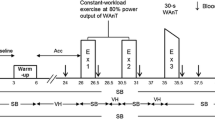Summary
Nine subjects performed a sequence of sustained and randomised changes between 40 W and 100 W on a cycle ergometer while the end-tidal\(P_{O_2 } \) was kept close to 17.3 kPa (130 mm Hg) by means of a dynamic forcing technique (reference experiment). In a second series inspiratory CO2 was additionally manipulated so as to hold end-tidal\(P_{CO_2 } \) (P ETCO2) near 6.5 kPa (49 mm Hg; ‘CO2-clamp’ experiment). By this forcingP ETCO2 oscillations were attenuated and more evenly distributed over the frequency range. Ventilation (\(\dot V_T \)) responded to this manoeuvre with an upward trend that could not be ascribed to a slow CO2-response component, changes in metabolic rate or a dissociation of end-tidal and arterial\(P_{CO_2 } \).\(\dot V_T \) differences between reference and CO2-clamp experiments were abolished within a 3-min period following the termination of the external CO2 control. The present results suggest that the CO2-H+ stimulus plays a major role in adjusting ventilation when exercise intensity is decreased. The underlying CO2 effect appears to be neither additive nor bi-directionally symmetrical.
Similar content being viewed by others
References
Anthonisen NR, Dhingra S (1978) Ventilatory response to low levels of CO2. Respir Physiol 32:335–344
Asmussen E, Nielsen M (1957) Ventilatory response to CO2 during work at normal and low oxygen tension. Acta Physiol Scand 39:27–35
Black AMS, Torrance RW (1971) Respiratory oscillations in chemoreceptor discharge in the control of breathing. Respir Physiol 13:221–237
Cerretelli P, di Prampero PE (1987) Gas exchange in exercise. In: Farhi LE, Tenney SM (eds) Handbook of physiology: the respiratory system, sect 3, vol 4. American Physiological Society, Bethesda, pp 297–339
Cunningham DJC (1975) A model demonstrating the importance of timing in the regulation of breathing. Nature 253:440–442
Dejours P (1959) La regulation de la ventilation au cours de l'exercise musculaire chez l'homme. J Physiol (Paris) 51:163–261
Dejours P, Puccinelli R, Armand J, Dicharry M (1965) Concept and measurement of ventilatory sensitivity to carbon dioxide. J Appl Physiol 20:890–897
Dutton RE, Hodson WA, Davies DG, Chernick V (1967) Ventilatory adaptation to a step change in\(P_{CO_2 } \) at the carotid bodies. J Appl Physiol 23:195–202
Eldridge FL (1972) The importance of timing on the respiratory effects of intermittent carotid body chemoreceptor stimulation. J Physiol (Lond) 222:319–333
Eldridge FL (1977) Maintenance of respiration by central neural feedback mechanism. Fed Proc 36:2400–2404
Eβfeld D, Stegemann J (1983) CO2-H+ stimuli and neural muscular drive to ventilation during dynamic exercise: comparison of stimuli at constant levels of ventilation. Int J Sports Med 4:215–222
Eβfeld D, Hoffmann U, Stegemann J (1987)\(\dot V_{O_2 } \) kinetics in subjects differing in aerobic capacity: investigation by spectral analysis. Eur J Appl Physiol 56:508–515
Forster HV, Klein JP, Hamilton LH, Kampine JP (1982) Regulation ofP aCO2 and ventilation in humans inspiring low levels of CO2. J Appl Physiol Respir Environ Exercise Physiol 52:287–294
Grodins FS, James G (1963) Mathematical models of respiratory regulation. Ann NY Acad Sci 109:852–868
Hickham JB, Pryor WW, Page EB, Atwell RJ (1951) Respiratory regulation during exercise in unconditioned subjects. J Clin Invest 30:503–516
Hoffmann U, Eβfeld D, Stegemann J (1990) Comparison of arterial, endtidal and transcutaneous\(P_{CO_2 } \) during moderate exercise and external CO2 loading in humans. Fur J Appl Physiol 61 (in press)
Loeschcke HH, Katsaros B, Albers C, Michel CC (1963) Über den zeitlichen Verlauf von Atemzugvolumen, Atem-Periodendauer, Atemminutenvolumen und endexpiratorischem CO2-Druck bei Einatmung von Gasgemischen mit erhöhtem CO2-Druck. Pfügers Arch 277:671–683
Martin BJ, Weil JV, Sparks KE, McCullough RE, Grover RF (1978) Exercise ventilation correlates positively with ventilatory chemoresponsiveness. J Appl Physiol Respir Environ Exercise Physiol 45:557–564
Nielsen M (1936) Untersuchungen über die Atmungsregulation beim Menschen, besonders mit Hinblick auf die Art des chemischen Reizes. Skand Arch Physiol 74 [Suppl]:293–313
Severinghaus JW (1981) A combined transcutaneous\(P_{O_2 } \)-\(P_{CO_2 } \) electrode with electrochemical HCO3 stabilization. J Appl Physiol Respir Environ Exercise Physiol 51:1027–1032
Swanson GD, Bellville JW (1975) Step changes in end-tidal CO2: methods and implications. J Appl Physiol 39:377–385
Swanson GD, Ward DS, Bellville JW (1976) Posthyperventilation isocapnic hyperpnea. J Appl Physiol 40:592–596
Wasserman K, Whipp BJ, Casaburi R (1986) Respiratory control during exercise. In: Cherniak NS, Widdicombe JG (eds) Handbook of physiology: control of breathing, sect 3, vol 2, pt 2. American Physiological Society, Bethesda, pp 595–619
Yamamoto WS, Edwards MW (1960) Homeostasis of carbon dioxide during intravenous infusion of carbon dioxide. J Appl Physiol 15:807–818
Author information
Authors and Affiliations
Rights and permissions
About this article
Cite this article
Eβfeld, D., Hoffmann, U. & Stegemann, J. Ventilatory effects of hypercapnic end-tidalPCO2 clamps during aerobic exercise of varying intensity. Europ. J. Appl. Physiol. 60, 412–417 (1990). https://doi.org/10.1007/BF00705029
Accepted:
Issue Date:
DOI: https://doi.org/10.1007/BF00705029




